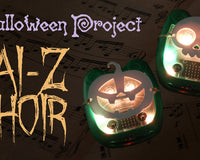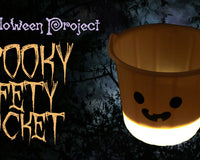An interesting part of the design process for amplifier enclosures is the discussion of resonance and quality of sound. Not only can this be affected by the shape and size of the chamber the speaker sits in, but also crucially the material used can be instrumental (pun intended) to bringing out the best sound possible.
This Make Covers:

We Have Used:
- Bluetooth Stereo Amplifier Module (2182).
- SPST Toggle Switch (3425).
- Steamed Beech Veneered MDF (3282).
- 8 x 8mm M3 Plastic Spacers (2306).
- 16 x 6mm M3 Pan Head Screws (2309).
- PVA Glue
- This DXF.
Design your Amplifier Enclosure!
As mentioned above, you must consider a few things while designing an enclosure for any speaker. Here are a few of the many factors that may need to be considered:
- Material choice will affect the sound produced. Its thickness, and even to some extent the adhesive used, will alter the sound in different ways.
- The speakers must be secure, or they may buzz or vibrate unpleasantly.
- The PCB should be mounted in a position central to both speakers, so the wires can reach it.

The button below links to the DXF we have used. Our basic design can be used to build upon or as a template from which to copy the hardware mounting sections to make designing easier for yourself.
Laser Cut your Enclosure!
Our design will look as below when cut, all from a single piece of Steamed Beech Veneered MDF. Our design features an engraving of a retro boombox, though you do not have to keep this design.

Mount the Switch & Speakers
This step could technically be done later, however, it can be beneficial to mount these parts at this stage so that you can gauge how long wires will need to be for the switch and also to check that the speakers will be able to plug into the PCB before you glue it all together.

Since we’ve used a toggle switch, we don’t have to worry about the orientation of the ON/OFF label (if you’ve engraved one on your design as we have). You can rotate it after the fact, once you can test your circuit!
The switch is mounted using the included washers and hex nuts, and the speaker we have mounted using four 10mm M3 pan-head screws and four nuts.
Solder the Switch to the PCB
The Bluetooth Amplifier Kit was updated with external switch pads at the beginning of 2025, and we will be using these to add our toggle switch. Solder the switch on as shown in the image below, with each contact on the switch connected to one of the two pads with a wire.

IMPORTANT NOTE: This image and the next few show the onboard switch in the ON position. You will need to switch it to OFF in order for the external switch to work as a bypass for that switch.
Mount the PCB
Screw the PCB onto the bottom panel (which has four unevenly spaced holes) as shown in the image. Fix a spacer to each hole using a 6mm pan head screw from underneath the panel, then another of the same screw can be used to screw the PCB to the spacers.

Begin assembling the enclosure
The top, bottom, and two sides can be glued together using PVA or Wood Glue as shown. Each corner has a diagonal brace with a screw hole, through which you should attach 8mm plastic spacers with a 6mm M3 pan head screw as shown. These will act as screw holes for the back panel so that the electronics are accessible.


Design your Amplifier Enclosure!
Using PVA, push on the front panel. You’ll want to clamp this in some way while the glue dries - we taped ours.
You can now attach the speaker leads to the connectors labelled L-SP (left speaker) and R-SP (right speaker). Make sure to get these the correct way around!

Screw on the back panel and add feet
As you can see in the image below - you can now screw on the back panel using four 6mm M3 pan head screws. we’ve added feet to ours - you can make your own from foam or grab some rubber ones like we did!

You’re Finished!
Plug into a USB-C power lead, turn it on, and pair the speaker to your device. You’re ready to rock!

Potential Customisations
- Add a LiPo battery. The Bluetooth Amp Kit can seamlessly transition from a unit powered by USB-C to a rechargeable portable speaker thanks to a built-in charging circuit. Just add a suitable LiPo!
- Consider using multiple materials. The look of a project can be elevated simply by adding accents in different colours and finishes. A great way to do this is to look through your material scrap pile and design accents that use up your offcuts.
©Kitronik Ltd – You may print this page & link to it, but must not copy the page or part thereof without Kitronik's prior written consent.






